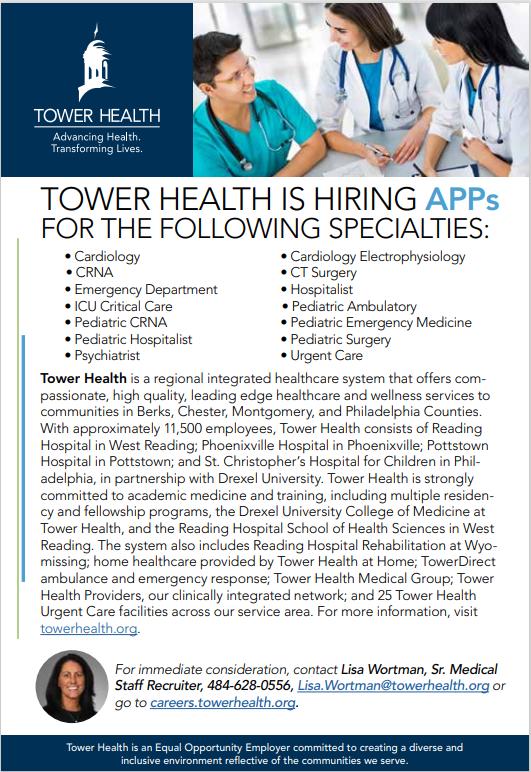Scholarship Symposium y
FRIDAY, APRIL 28TH, 2023

- WEHRHEIM SCHOOL OF NURSING- MILLERSVILLE UNIVERSITY




















































Thank you for joining our 26th Annual Scholarship Symposium. When I started at Millersville in 2000, this event was called the MSN Colloquium, which means “academic conference or seminar.” Over the years, the event has evolved to include our DNP students and in the in the mid 2010’s, we decided to change the name to the Scholarship Symposium. Our Symposium is so much more than just an academic conference – it is truly a showcase of nursing innovation, knowledge, professionalism, and networking. We love welcoming our organizational partners to highlight the amazing work of our students. I would like to provide special thanks to the faculty who have organized this event, as well as those who have mentored the students you will see featured today. I hope you enjoy the day as much as we have enjoyed working with our students to prepare!

3










 Kelly A. Kuhns, PhD, RN, CNE Chair and Professor Wehrheim School of Nursing
Kelly A. Kuhns, PhD, RN, CNE Chair and Professor Wehrheim School of Nursing


MSN Podiums






Receive 2.75 Contact Hours for attending this session

26th Annual Scholarship Symposium

11:15








(Please feel free to eat and enjoy lunch while you socialize and review the poster presentations)
11:30

Poster Group A
12:00
Poster Group B
Receive 1.00 Contact Hours for attending this session
12:30
Breakout Sessions: MSN in MPR DNP in Room 118E 14:00 Break 14:15
MSN Podiums 15:00
Closing and Awards
15:30







Reception: Raney Cellars
11 Manor Ave, Millersville, PA 17551
Receive 2.25 Contact Hours for attending this session

THE EFFECTS OF TELEPHONE FOLLOW-UP ON SECONDARY STROKE
PREVENTION
Naomi Acheampong
IMPROVING TREATMENT ADHERENCE AMONG OPIOID USE DISORDER
PATIENTS
James Ndungu
IMPROVING CHILD SEX TRAFFICKING EDUCATION IN AN EMERGENCY
DEPARTMENT
Jocelyn Ramirez Harrell
7






USING AN EDUCATIONAL INTERVENTION TO MOTIVATE FIREFIGHTERS TO SCHEDULE AN ANNUAL PREVENTATIVE HEALTH EXAMINATION
Emily Serikstad
THE IMPACT OF SUBSTANCE USE DISORDER EDUCATION ON NURSES'
KNOWLEDGE AND ATTITUDES
Julia Wauchope
IMPROVING INTERDISCIPLINARY COLLABORATION IN CARING FOR PATIENTS WITH EXTRACORPOREAL MEMBRANE OXYGENATION (ECMO)
Kelly Williams
INTERVENTIONS AIMED TO ELIMINATE ADVANCE PRACTITIONERS'
BURNOUT IN CLINICAL PRACTICE: A LITERATURE SYNTHESIS AIMED TO IMPROVE CLINICAL PRACTICE
Porsha Barbosa
ACCESS TO DENTAL HEALTH CARE IN CENTRAL PENNSYLVANIA: A
FORMAL NEEDS ASSESSMENT TO PROPOSE A DENTAL RESIDENCY AT A 7-HOSPITAL SYSTEM
Elizebeth Edmister
8







EATING DISORDER SCREENING TOOLS FOR PATIENTS WITH TYPE 1
DIABETES: RECOMMENDATIONS FOR THE NURSE PRACTITIONER
Caitlyn Kristich
COMPREHENSIVE GERIATRIC ASSESSMENT AND DIFFERENT SCREENING
TOOLS FOR IDENTIFYING GERIATRIC POLYPHARMACY
Linda Asomaning
PREVENTING CHILDHOOD OBESITY THROUGH DIET, EXERCISE, AND BMI MONITORING TECHNIQUES: FAMILY PRACTICE
RECOMMENDATIONS

Holly Carney
CARING FOR PATIENTS WITH OBSTRUCTIVE SLEEP APNEA:
IMPLICATIONS FOR THE FAMILY NURSE PRACTITIONER
9








Tobi Coen
UNDERSTANDING THE NEEDS OF CANCER SURVIVORS POST-
TREATMENT TO IMPROVE QUALITY OF LIFE: RECOMMENDATIONS FOR NURSE PRACTITIONERS
Annetta Czar
MENTAL HEALTH BENEFITS OF SPENDING TIME OUTDOORS
Lauren Earnshaw
HUMAN TRAFFICKING AND REDUCING HEALTHCARE PROVIDER
DISSERVICE IN CARE AND RECOGNITION OF VICTIMS
Brianna Ensor
MEDICATION REDUCTION WITHIN THE GERIATRIC POPULATION: IMPLICATIONS FOR FAMILY NURSE PRACTITIONERS
Vincent Grove

EFFECTIVENESS OF GAMIFICATION FOR NURSING ORIENTATION
Bailey Premo
THE EFFICACY OF PULMONARY REHABILITATION IN REDUCING THE RISK OF READMISSION AND MORTALITY IN PATIENTS WITH CHRONIC
OBSTRUCTIVE PULMONARY DISEASE








Lindsey Smith
THE STIGMA OF SUBSTANCE USE DISORDERS: PROVIDER BIAS AND THE IMPACT ON CARE
Christina Trees
MEDITERRANEAN DIET AND DEPRESSIVE SYMPTOMS
Zhanna Demyantsev
CONTINUOUS GLUCOSE MONITORING IMPROVES AUTONOMY AND DECREASES HYPOGLYCEMIC EVENTS IN ADOLESCENCE
Stephanie Erb
THE EFFECTIVENESS OF PSILOCYBIN TREATMENT FOR DEPRESSION IN THE ADULT POPULATION: A LITERATURE SYNTHESIS








Paige Lindsay
HEALTHCARE PROVIDER WEIGHT STIGMA, IMPACT ON PATIENT
OUTCOMES AND INTERVENTIONS: A LITERATURE SYNTHESIS AIMED TO

IMPROVE CLINICAL PRACTICE IN PRIMARY CARE AND BEYOND
Ana Lynch
Prostate Cancer and Early Screening: Recommendations for the Primary Care Provider
Shaughnessy Migash
USE OF A WHOLE FOODS PLANT-BASED DIET IN THE MITIGATION OF CARDIOVASCULAR DISEASE AND RISK FACTORS: IMPLICATIONS FOR FAMILY NURSE PRACTITIONERS
Maliseni Mulenga








Improving Quality of Life and Reducing Readmissions in the Adult Heart Failure Population: Implications for the Family Nurse Practitioner
Elyse Potter
EFFECTS OF THERAPEUTIC TOUCH IN CHRONIC PAIN RELIEF FOR ADULT PATIENTS IN PRIMARY CARE SETTINGS: A CALL TO ACTION
Mary Silveira Pelin
IMPROVING HUMAN PAPILLOMAVIRUS VACCINE HESITANCY THROUGH EDUCATION BY PRIMARY CARE PROVIDERS
Kristina Thresher
THE EFFICACY OF ACUPUNCTURE WHEN USED FOR PAIN RELIEF IN ADULT PATIENTS WITH KNEE OSTEOARTHRITIS
Nathan White

PRESCRIBING CONSIDERATIONS AND DRUG AVAILABILITY FOR THE FAMILY NURSE PRACTITIONER: MODERATE TO SEVERE PLAQUE
PSORIASIS






Katie Folkenroth
FAMILIAL HYPERCHOLESTEROLEMIA RISK IDENTIFICATION AND INTERVENTION IN CHILDHOOD: A LITERATURE SYNTHESIS AND
PRACTICE RECOMMENDATIONS FOR THE FAMILY NURSE
PRACTITIONER
Taylor Gainer
EFFECT OF MUSIC THERAPY ON AGITATION IN OLDER ADULTS WITH
COGNITIVE IMPAIRMENT: A NONPHARMACOLOGICAL INTERVENTION FOR FAMILY NURSE PRACTITIONER CONSIDERATION
Kimberly Martin
PROBIOTICS AND THE GUT BRAIN AXIS IN PATIENTS WITH DEPRESSION AND ANXIETY: IMPLICATIONS FOR THE FAMILY NURSE
PRACTITIONER

Alexis Phillips
STRATEGIES FOR PRIMARY CARE NURSE PRACTITIONERS TO FACILITATE EARLY DETECTION OF AND EFFECTIVE TREATMENT FOR PEDIATRIC ANXIETY
Rachel Sensenig
THE MEDITERRANEAN DIET VERSUS THE PLANT-BASED DIET: A
REVIEW OF LIPID-LOWERING EFFECTS OF THE DIET IN ADULT
PATIENTS
Janelle Wentzel
COULD THE SECOND VICTIMS PLEASE STAND UP? RECOGNITION OF HOW WE HELP THOSE WHO HELP OTHERS.
Jessica Borthwick
THE COMMUNITY RESILIENCE MODEL APPLICATION IN FRONTLINE
COMMUNITY CASEWORKERS IN A LOCAL CHILDREN AND YOUTH AGENCY
Susan Brackbill
COMPARING COLLABORATIVE LEARNING AND TRADITIONAL
LEARNING IN GRADUATE NURSING EDUCATION
Jaima Brown Kishbaugh
POSTERIOR CIRCULATION STROKE: TIMELY RECOGNITION AND TREATMENT
Sarah Keller
REDUCING MENTAL HEALTH STIGMA AMONG PRIMARY CARE PROVIDERS
MiKaila Lugo-Schlegel
IMPLEMENTATION OF A MINDFULNESS INTERVENTION AMONG





CAREER FIREFIGHTERS AND THE EFFECT ON PERCEIVED STRESS
LEVELS
Rachel Mowry

THE IMPACT OF SERVICE LEARNING ON LEADERSHIP COMPETENCE AND CULTURAL COMPETENCE IN UNDERGRADUATE NURSING STUDENTS
Paula Mastroianni
UNDERSTANDING CUTANEOUS MANIFESTATIONS OF GASTROINTESTINAL CONDITIONS IN THE FAMILY PRACTICE SETTING
Bethany Schwartz
TELEMEDICINE AND CONTRACEPTIVE CARE: IDENTIFYING SAFETY
CONSIDERATIONS AND OVERCOMING DISPARITIES
15






Domonique Scott








Secondary stroke prevention requires extensive patient teaching to improve co -morbidities, reduce incidence and recurrence of stroke. While stroke education is a requirement by the Joint Commission during hospitalization, knowledge retention is found to be poor at the initial neurology clinic appointment at six to eight weeks post hospitalization. Post-hospitalization is when a patient leaves the hospital after treatment to either go home or rehab (Merriam-Webster, 2022). The purpose of the project is to determine if implementation of structured telephone follow-up in outpatient stroke clinic visit post hospitalization will improve stroke knowledge retention and lifestyle behavioral modifications post hospitalization? A convenient sample of patients diagnosed with mild ischemic stroke or transient ischemic attack was recruited from a rural hospital outpatient stroke clinic. A pretest survey was done prior to the implementation of secondary stroke education to collect data at baseline. A subsequent telephone follow-up, one at two weeks and another at four weeks was implemented for each patient after their follow-up visit by a nurse practitioner. During the telephone call, patients were asked the same questions on the pretest survey used at the initial visit to measure secondary stroke prevention knowledge retention and a Likert scale was used to measure whether the secondary education re-enforced at the visit improved lifestyle behavioral modifications such as smoking cessation, blood pressure monitor at home (at least once a day), 30 minutes exercise three times a day and medication adherence. Data was collected at baseline and during the two weeks and at four weeks after their initial outpatient visit. For statistical data analysis a paired T-test was used. Implementing telephone follow-up to improve prevention of stroke via improved health behaviors, decrease hospital admission, decrease stroke recurrence through knowledge and stroke risk, and lifestyle modifications to those risk.


The prevalence of opioid use disorder (OUD) in the United States is at a record high and continues to rise sharply. In the period ending April 2021, there was an estimated 100,306 drug overdose deaths in the United States. This was a 28.5% increase from the previous year. This increase in opioid related overdoses has led to the expansion of Office based Opioid Treatment (OBOT) which has significantly improved access to safe and effective opioid dependence therapy in primary care offices. In addition to medication management, the American Society of Addiction Medicine (ASAM) also recommends psychosocial interventions which have always been the standard of care in Opiate treatment programs (OTP). There is however limited literature on recommendations for specific psychosocial interventions in OBOT programs. There is therefore a need to gain a better understanding of the psychosocial interventions needed. This review will look at the retention rates of patient with a history of opioid use who are on mediation assisted treatment with no psychosocial counseling compared to a group of patients who have a brief counseling session with their provider at the scheduled medicationappointment.






There are no widely implemented methods for recognizing and screening for victims of child sex trafficking in emergency department settings in the United States. Determine if implementation of a quality improvement program to educate nursing staff on identifying potential victims of human and child sex trafficking in an emergency department leads to increased perceived knowledge in identification of potential victims. Major themes throughout literature included staff education, characteristics of victims, child focused screening, and mixed population screening. An online based module was created for emergency department staff members to complete focusing on key topics such as definitions of human trafficking, child sex trafficking, labor trafficking, differences between conventional child sex abuse and child sex trafficking, risk factors, victim characteristics, local,state,and federalagenciesfor support.Preeducation and post-education perceived knowledge utilizing the Human Trafficking Education Tool was measured. In addition, basic demographic data was collected as well as comments for improvement of the module. The module was self-paced, and participants had six weeks to complete the education. Utilizing two-tailed two-sample t-test to examine the data, pre-education and post-education means, statistical significance was identified for several of the tool items. This module may be beneficial to implement in other emergency departments, however, changes may need to be made in recruitment of participants due to project limitations.



Sudden cardiac death constitutes approximately 45% of volunteer and career firefighter line-of-duty deaths according to the Centers for Disease Control and Prevention (2018). Firefighters are at an increased risk of sudden cardiac death for a multitude of reasons. Research has shown that requiring mandatory annual preventative health screenings is one of the most effective methods and most common recommendations made to help prevent adverse cardiac events in the fire service. The aim of this project is to determine if implementing an evidence-based education program reviewing the importance of annual preventative health examinations encourages firefighters to undergo an examination by a licensed provider. A preimplementation survey will be distributed among firefighters within a department determining how many firefighters have had a preventative health examination within the last year. An evidence-based education program will then be implemented regarding the importance of undergoing a yearly health examination by a licensed provider. For those who have not had a health examination in the last year, they will have six weeks to make an appointment for a health examination. A postimplementation survey will then be distributed determining if the education provided encouraged firefighters to get a preventative healthexamination.





The number of healthcare workers, particularly nurses who are affected by substance use disorder (SUD) have increased over the past decade and now matches the general population. Without action, this issue will continue to negatively affect patient safety (Mumba & Kraemer, 2019). The purpose of this quality improvement (QI) project was to implement a 30-minute SUD educational intervention for nurses working within a psychiatric hospital. The specific aim was to improve the participants’ knowledge and attitudes about SUD. Additionally, to create awareness of the procedure that nurses should follow to report suspected impaired peers. The participants were recruited from a psychiatric hospital in Southeastern Pennsylvania. This project evaluated nurses’ knowledge level before, immediately after, and six weeks post-educational intervention through the administration of a test. The nurses’ attitudes towards SUD was evaluated through the administration of the Brief Substance Abuse Attitude Survey (BSAAS) tool. The data from the sample was analyzed by SPSS. Descriptive statistics was used to obtain information on the sample. The paired t-test was computed to compare the pre-and post-tests. Wilcoxon signed-rank test was used to compare the pre-and post-familiarity scores and pre-and post-BSAAS scores. There were 25 participants. There were statistically significant differences between the test scores following the SUD education. Preand post-test scores (p<0.001), pre-and six weeks post-test scores (p=0.001), and post-and six weeks post-test scores (p<0.001). There was statistically significant difference between the pre-and postfamiliarity score (p<0.007). There were no statistically significant changes in the attitudes of nurses following the SUD education. The project findings support the need for further training and the expansion of SUD professional development education within this organization and other health systems in order to eradicate the negative outcomes related to impaired nurses.




Patients on extracorporeal membrane oxygenation (ECMO) support are at increased risk for adverse events due to severity of illness and complications associated with the ECMO circuit, requiring complex care that includes a multidisciplinary team. Effective communication and collaboration are essential regarding daily management and goals for these patients which must be understood by all team members. The purpose of this project was to develop a structured communication tool for use during multidisciplinary rounds in the care of patients on ECMO to improve interdisciplinary collaboration, staff satisfaction, and enhance understanding of patient goals of care. The tool was implemented for 10 weeks on all patients requiring ECMO support in a large tertiary care center. Pre- and post-intervention surveys utilizing the Collaboration and Satisfaction about Care Decisions (CSACD) instrument were given to all ECMO staff to evaluate perceptions of interdisciplinary collaboration and satisfaction, and two questions to evaluate self-reported understanding of the plan of care. Response rates of 67% (n=51) and 65% (n=47) were achieved in the pre- and post-surveys, respectively. Mean scores for collaboration, satisfaction, and understanding improved overall. There were statistically significant improvements in collaboration scores (p = 0.0046) using the paired t test to compare sample means (n=19 matched respondents). This project was successful in implementing the structured communication tool and results indicate that it helped to improve interdisciplinary collaboration in the care of patientsonECMO.





Could the second victims please stand up? Recognition of how we help those who help others.



If have experienced a crisis please raise your hand? Healthcare providers have a high probability of experiencing a tragic, unexpected, or catatonic event. Support, from a system perspective, for this population after such situations can be variable or absent. The time for enculturation of a program that helps identify, define cognitive, behavioral, and emotional response, and reflect on an incidentinastructuredmannerisnow. The next steps for implementing evidencedbased practice debriefing begins today.


Frontline caseworkers in the Child Welfare system are at high risk for vicarious trauma due to working with highly traumatized families with multiple forms of abuse. Vicarious trauma can lead to ineffective coping skills, poor sleep hygiene, stress and burnout, and many other physical and psychological conditions. Unmitigated stress and burnout can lead to job dissatisfaction and retention (Grabbe et al., 2021). High turnover negatively affects the agency’s culture, and as a relationship-based support system, frequent changes in caseworkers can negatively impact family outcomes. This proposal aims todeterminetheeffectivenessofanevidence-basedtool to support frontline Child Welfare caseworkers with an evidence-based intervention, the Community Resiliency Model. The model provides simple steps to engage in self-care that mitigate the long-term effects of prolonged trauma and stress, with the hope of enabling continued employment and promotion of effective relationships between caseworkers and families supported through Child Welfare Services.



The advanced practice nurse (APN), such as a family nurse practitioner or nurse anesthetist, face many demands as they move into their new roles, often moving from an expert registered nurse in their chosen field, to a novice advanced practice nurse in their new role. APN education can be variable through the many options and programs available, with emphasis on common core theoretical concepts and application of those concepts. Over the past ten years, due to the growing population of APN’s, the International Nursing consortium has identified the need to emphasize diagnostic reasoning (DR) and its use, both in theory and application in APN education. The ability to accurately diagnose a patient is a key skill that requires mastery prior to graduation and independent practice at the bedside. DR is an analytical process used to correctly diagnose and treat a patient, taking into consideration subjective symptoms, examination findings, laboratory studies, imaging results, and the formulation of a diagnosis and treatment plan. Through a literature synthesis, traditional didactic learning methodologies were compared against application of a think aloud oral examination to identify if this improved the highly sought after, and desirable ability to improve diagnostic reasoning in APN family nurse practitioner students. After IRB approval, a pre and post design evaluated the diagnostic reasoning processes of two cohorts of family nurse practitioner students in their second clinical practicum class. The current evidence and further plans will be discussed.
Brown-Kishbaugh






Acute ischemic stroke in the posterior circulation accounts for about 20-25% of ischemic strokes. Posterior circulation strokes are misdiagnosedmorethantwiceasoftenasanterior circulationstrokes.Delayedormisdiagnosisplaces patients at higher risk of complications and recurrent strokes from lack of treatment for the vascular pathology and implementation of secondary stroke prevention strategies (Gurley & Edlow, 2019). The wide range of non-specific symptoms, such as vertigo or dizziness, nausea, vomiting, headache, alteration of consciousness, gait ataxia, dysarthria, and nystagmus contributes to misdiagnosis or delay recognition (Sparaco et al.,2019).Integratingtriggersintonursingpractice that encourage recognition of posterior circulation stroke impacts timeliness of treatment and lowers the risk of complications.



Mental health is becoming known as a “silent killer.” One in five people are diagnosed with a mental illness each year, with 6% of those individuals specified as severe. Mental health stigma is a universal paradox, negatively affecting individuals with a mental illness diagnosis. Stigma is developed from negative bias, labels, perceptions and discrimination, leading to a deterioration ofsymptoms, reducedhope, loweredself-esteem, and decreased probability of complying with treatment. Individuals experience twice the problem, symptoms of the disease itself and stigmatization from others. Mental health stigma results in barriers to health care, treatment and recovery. The purpose of this Doctor of Nursing (DNP) project is to incorporate the National Alliance of Mental Illness’s (NAMI) In Our Own Voice (IOOV), a 60 minute presentation into the curriculum of the graduate level FNP program in southeastern PA to evaluate if educating FNP students on mental health stigma improves their attitude towards individuals with mental illness and decreases their mental health stigma. Addressing the knowledge and attitudes regarding mental health stigma among primary care providers is one evidencebased strategy to address patient stigma. Current evidence and future plans will be discussed.





Firefighters experience high levels of stress related to their occupation that negatively impacts their physical and mental health and can lead to loss of occupation, decreased work productivity, and suicide. Occupational stress in firefighters impacts firefighters as individuals, the workplace, and communities; therefore, this phenomenon should be evaluated. The aim of this Doctor of Nursing (DNP) project is to explore the effects of mindfulness interventions for professional firefighters. Mindfulness is a strategy that has been shown effective in reduction of occupational related stress. Findings in the literature demonstrate that implementation of mindfulnessbased strategies can be delivered through a variety of methods including mindfulness-based stress reduction, mindfulnessbased cognitive therapy, virtual mindfulness interventions, and other structured programs. Increased mindfulness has been shown to be effective in improving stress through increased emotional regulation, improvement of sleep, development of coping strategies, and enhancement in psychological resilience. Despite the amount of available evidence, further investigation regarding mindfulness-based interventions and the effect on occupational stress in professional firefighters is warranted.





Frailty, various co-morbidities, and a decline in physical, physiological, and mental health make the rise in polypharmacy among the geriatric population an essential issue. Recent studies on screening tools used to identify polypharmacy involving multiplediseases have paid little attention to the elderly (Mangin et al., 2018). Polypharmacy refers to the use of five or more medications. This capstone project elevates the literature on screening tools currently in use for identifying polypharmacy. The Comprehensive Geriatric Assessment (CGA) tool was used to compare the American Geriatrics Society (AGS) Beer criteria, STOPP (Screening Tool of Older Person's Prescriptions), START (Screening Tool to Alert Doctors to the Right Treatment), and the Medication Appropriateness Index (MAI). Some of the databases that were searched to answer this clinical query were OVID, CINAHL, Cochrane Library, Medline, and PubMed. The studies that were analyzed confirmed that using these tools helped with polypharmacy identification. There are benefits and drawbacks to using any of these tools. Overprescribing and Potential Inappropriate Medication (PIM) can be identified using the Beers, START, STOPP, and MAI criteria. The CGA is an efficient tool for identifying polypharmacy due to its emphasis on a thorough assessment of all medications and patient characteristics (Bahat et al., 2018). The CGA's disadvantages are that it takes time and is difficult to bring providers into partnership. For CGA, the elderly is sometimes referred to a geriatrician, which delays care. Studies have shown that trained non-geriatrician healthcare providers can effectively administer the full CGA (Sum et al., 2022). Managing multiple medications at once is made easier by using the CGA, especially for the elderly. The CGA has an edge over alternative screening tools since it considers the nuances of geriatrics, including their preferences and multi comorbidities. CGA is evidence-based, and it should be used to make better informed choices.





The challenging nature of the healthcare environmenthas served at the core of various debates in recent years due to its impact on practitioner well-being. Research findings show that advanced practitioners (APP), defined as a nurse practitioner or a physician assistant, report high levels of dissatisfaction and turnover, which is attributed to burnout. As a psychological state, burnout is often characterized by a decline in effectiveness, increased emotional exhaustion, and depersonalization. APPs are at high risk of burnout due to the work environment's structural, organizational, and contextual characteristics. The lack of wellness programs has furthered the issue, with more practitioners shifting from the discipline in search of favorable work environments. The high attrition and turnover rates have contributed to gaps in the workforce and decreased access to healthcare resources, thus increasing disparities, morbidities, and mortality rates. This paper aims to synthesize and review current research on interventions to eliminate APP burnout in clinical practice. The literature search and synthesis break down the various consequences of advanced practitioner burnout on the patients, healthcare entities, and the system in general. The literature search involved searching five databases using keywords related to the topic to identify pertinent articles. The search proposed improving the quality of the work environment for APPs. The results from this research are substantial in improving knowledge of the impact of burnout on healthcare practitioners. The research recommends that APPs develop an inclusive, collaborative, and conducive milieu that reduces their risk of burnout.






Childhood obesity is a serious dilemma with a prevalence that has tripled in the United States over the last four decades. It can affect children psychologically and physiologically causing issues with self-esteem, body image, and overall health. The American Academy of Pediatrics identifies childhood obesity at or above the 95th percentile of Body Mass Index at a given age. The CINAHL, PubMed, and MEDLINE databases were used to obtain peer reviewed articles that determine how providers can help prevent childhood obesity. The Johns Hopkins evidence appraisal tool was used to evaluate the literature. An extensive review of the literature was conducted to identify the best interventions by providers in the primary care setting in order to prevent childhood obesity. The American Academy of Pediatrics recommends following their guidelines, using effective tools, and making small to moderate lifestyle modifications through the use of diet and exercise. Providers’ individual preferences and habits can create gaps between recommended guidelines and what they actually practice. There is a need for more education for providers in improving utilization of the American Academy of Pediatrics guidelines in their practice. Implementing clinical guidelines may improve patient outcomes, as well as quality and consistency of care for obese children. Barriers that may affect implementing these guidelines into practice may include lack of training, lack of time, lack of resources, and patient, and provider sensitivity to the subject of childhood obesity.




Obstructive Sleep Apnea (OSA) is becoming increasingly prevalent around the world as a contributor to early morbidity and increased mortality. OSA causes frequent nighttime awakenings and apnea which causes a drop in oxygen. OSA has negative effects on the cardiovascular and pulmonary systems and is a contributor to the development of certain cancers and depression. The effects of undiagnosed OSA on the patient and the healthcare system are tremendous. Despite this, only a small percentage of patients who are at risk for developing OSA are screened by their primary care provider. Early screening, detection, and referral to sleep studies must be completed for patients who are at risk for developing OSA. Providing early interventions, such as CPAP, can prevent patients from developing the negative health effects that OSA has on the body. The purpose of this capstone project was to answer the following question: What screening tool has been demonstrated to be the most effective in early diagnosis of Obstructive Sleep Apnea (OSA) in general family practice? The CINAHL, EBSCO Host and Google Scholar databases were searched for scholarly journal articles with date parameters of 2017-2023. Further parameters such as studies with adults aged 1944 years old and studies that focused on primary care and general family practice were applied. The Johns Hopkins Evidence-Based Practice Evidence Level and Quality guide was used to evaluate 11 articles. The overall theme of this research showed that undiagnosed OSA can have significant negative health implications if left untreated. Currently, there is insufficient screening for OSA in primary care and the most effective tool to use for screening for OSA is the STOPBANG questionnaire. Family Nurse Practitioners should screen for OSA during yearly exams by utilizing this efficient and concise screening tool.



After completing cancer treatment, a patient should receive a follow-up care plan according to the current standard of care model. The problem is cancer survivors feel confused and mislead from a lack of direction and availability of supportive care. The aim of this literature review is to understand what quality of life post-treatment cancer survivors are experiencing and provide recommendations for the nurse practitioner, on how to better meet the needs of cancer survivors to increase satisfaction and health outcomes after treatment. Ten systemic reviews and two randomized control trials were reviewed. These articles were evaluated using the Johns Hopkins Evidence Appraisal Tool. The results revealed that there is a continued provider shortage with growing rates of cancer survivors. This increased demand makes meeting the needs of cancer survivors no longer sustainable. The literature synthesis concluded that implementation of survivorship care plans as a standard of care for cancer survivors after completing treatment is the new standard of care. Survivorship care plans monitor for late or lasting physical and psychological effects of treatment. Early detection of such effects can help improve cancer survivor satisfaction of care and quality of life. Implementing advanced practice providers (APP), such as nurse practitioners, can also help to overcome the ongoing provider shortage and allow for optimization of survivorship care plans. An optimal survivorship care plan should review what treatments the patient completed, what late and long-term effects the patient can experience, what the timeline for follow-up appointments and screening intervals are, and what support resources are available. Healthy living education and guidance after treatment can also help to improve the health outcomes of cancer survivors. With these few actions the care of cancer survivors can be greatly improved.
Annetta Czar


Depression is one of the most prevalent and debilitating diseases affecting many individuals worldwide. Treatment options for depression mainly focus on the brain, including antidepressant pharmaceuticals and psychotherapy. With increased evidence of the gut-brain axis as the root cause of depression, a different approach focusing more on gastrointestinal (GI) health may emerge as an alternative treatment and prevention for depression. Dietary habits are a modifiable risk factor that significantly influences GI health. A Mediterranean diet (MD) is a healthy diet consisting of whole foods and healthy fats. The nutrient-dense foods in the MD are associated with positive health outcomes, including mental health. For this capstone project, 20 academic journal articles were obtained and evaluated using the Johns Hopkins Evidence-Based Evidence Level and Quality Guide to determine if, in the adult population, adherence to an MD compared to a non-MD improves depressive symptoms. As a result, most studies support that adherence to an MD decreases depressive symptomology and decreases the risk of depression in an adult population. With more than half of the studies being a cross-sectional design, it is recommended that additional prospective or randomized controlled studies are conducted in future research to evaluate the causal relationship effect between MD and depression. As research continues to evolve on this topic, incorporating an MD as a complementary therapy for depression may have beneficial and therapeutic effects on mental health and depressive symptomology.

 Zhanna Demyantsev
Zhanna Demyantsev




The physical and psychological impact of spending time outdoors on people has been an interesting area of research. During the lockdown and the Covid 19 pandemic, people’s preference of being exposed to green and blue spaces have increased. The lockdown was imposed as an epidemic control measure that increased the frequency of outdoor activities and highlighted the mental health duress experienced when confined to being indoors. Previous research has linked spending time outdoors to reduced stress, purpose in life, and improved cognitive abilities. Previous studies have explored the impact of green space on mental health, while in more recent years, blue spaces have become an emerging area of interest. The evidence indicates that outdoor activities help improve the mood of individuals experiencing stress. Several databases, including CINAHL, PubMed, and The Cochrane Library, were searched to find articles about the outdoors and mental health. Research studies published between 2018 and 2022 were selected. Twenty-two papers were selected and appraised using the Johns Hopkins evidence-based practice model . Quantitative and qualitative research articles were used to establish a relationship between nature and mental health. Outdoor activities improved moods in cases where the participants were stressed, promoted cognitive development among children and improved memory capacity in adults. People who engage in outdoor activities have an increased sense of purpose in life. Spending recreational time in green spaces aids in reducing the risk of developing various psychiatric disorders and significantly reduced the risk of sleep, mood, and substance abuse disorders. Continued research and randomized control trials are needed to solidify previous evidence.


According to the Centers for Disease Control and Prevention and the Healthy People 2030 national objectives, oral health is one of the ten leading health indicators. Periodontitis, or gum disease, is associated with an increased incidence of obesity, type 2 diabetes, hypertension, heart disease, and many other serious health complications. Nearly 65 million adults over the age of 30 suffer from some form of gum disease, due to lack of basic dental care. These people often present to a primary care, urgent care, or the emergency department (ED) setting to have their dental needs addressed. Lack of insurance, low-income variants, no access to dental care, and no available primary care physician have been identified as negatively impacting a Central Pennsylvania (PA) hospital system’s ED. Using retrospective data, a needs assessment was preformed focusing on the number of dental complaints presenting to seven EDs, local primary care or urgent care offices within the health system. One of the objectives of the needs assessment was to determine the need for a general dentistry residency program within that geographical region. The health system examined encompasses seven acute care hospitals and over 160 outpatient clinics that serve 11 counties in South Central PA. As a result of the data review, the needs assessment found that over 1,200 patients presented to one of the seven EDs, and over 500 patients presented to an outpatient facility within a six-month period; March 1, 2022, through August 31, 2022 with a dental complaint. A formal business plan with local dental stakeholders, as well as UPMC Central PA administration is in process; to outline specific details of location, administration of the residency and the application process to obtain a Commission of Dental Accreditation (CODA) residency within the Central PA area. The implementation of a dental residency program within the UPMC Central PA health system has the potential to increase community access to dental care. This includes services to the uninsured and underinsured population, providing hands-on experience to those in the dental residency program, serving as a referral source for local primary or urgent care offices, provide an optional dental service to UPMC employees, and serve as an inpatient consulting service for seven UPMC Central PA hospitals. The clinic has the potential to decompress the emergency department of non-emergent dental complaints and increase throughput in the emergency department.






Human trafficking also referred to as modern day slavery, is a major human rights crime encompassing millions of victims worldwide. The significance of this pandemic often lacks greater recognition by the media, the public, and medical personnel. Data collected across the United States in 2021 from the National Trafficking Hotline reported a total of 10,359 situations which yielded a total amount of 16,554 trafficking victims identified. A common misconception is that human trafficking primarily occurs in large cities, but this is false. In 2020, it was reported that 221 cases of human trafficking were reported across Pennsylvania alone. Victims of human trafficking range across all ages, ethnicities, genders, and geographical locations. The family nurse practitioner’s role is to care for patients across the lifespan, so the likelihood of encountering and caring for a victim of human trafficking is extremely high. Research shows that during captivity, 87.8% of women who later came to escape modern day slavery encountered a healthcare practitioner one or more times during their imprisonment. It is extremely important for the family nurse practitioner to be educated on any available screening methods, recognition strategies, and stigmas associated with victims of human trafficking to better serve this vulnerable population. The purpose of this capstone project is to review and synthesize available data and research to guide practice for the family nurse practitioner in caring for and recognizing patients who are victims of human trafficking. A thorough electronic database search was conducted utilizing CINAHL, EBSCO host, MEDLINE complete, and ScienceDirect. Literature compiled was evaluated utilizing the John Hopkins Evidence Appraisal Tool. Review of literature indicates need for more research due to limited findings. Very few approved screening tools were identified, and few are available for the advanced practice provider to identify human trafficking victims, which only stresses the importance of better education regarding trafficking.

Continuousglucosemonitoring(CGM)isadeviceused by patients with type 1 and type 2 diabetes to continually monitor their blood glucose level. Adolescents who were diagnosed with diabetes have increased their autonomy and improved their control of diabetes by using a CGM verses daily glucose fingerstick. The use of daily glucose fingerstick is time consuming and can create a level of insecurity for the newlydiagnoseddiabeticadolescent.TheCINAHLand MEDLINE databases were used to gather high quality research articles and the John Hopkins evidence appraisal tool was used to evaluate each article. Searches focused on using the question: For adolescents, diagnosed with type 1 diabetes mellitus (T1D), does monitoring blood glucose with continuous glucose monitoring (CGM) or the use of glucose testing with traditional finger sticks improve blood glucose control and autonomy? Adolescent patients with T1D struggle with uncontrolled blood sugar levels and autonomy. CGM provides an option to improve hypoglycemic events and increase autonomy for the adolescent population.
Stephanie L. Erb






Plaque psoriasis is a chronic skin disease that requires ongoing therapies and treatment. There are dated and more current techniques, pharmacological therapies, topical medications, and systemic treatment options that are available to the family nurse practitioner for prescribing. Patients with this disease are often undertreated due to the overwhelming variety of available therapies. Clear practice guidelines and implications of these treatment options is essential in improving patient outcomes and satisfaction. It is imperative for the family nurse practitioner to understand the comprehensive effects of this disease and the drug availability when initiating a prescription. By considering prescribing variables, the nurse practitioner can effectively and competently prescribe a treatment plan for moderate to severe plaque psoriasis. Meticulously choosing a treatment plan that is individualized for each patient can affect the outcome, severity, and improve patient satisfaction with this disease. Understanding efficacy, cost, side effects, and risks, can impact which treatment route to select. Informed decision making is the best way for the family nurse practitioner and patient to select a treatment plan that is custom to his or her individualized plaque psoriasis. CINAHL, PubMed, and Google Scholar databases were utilized to obtain research articles related to prescribing variables and drug availability for the treatment of plaque psoriasis. These articles were evaluated thoroughly with the use of the Johns Hopkins Nursing Evidence-Based Practice Evidence Appraisal Tool. An overall dissection and evaluation of the literature was completed to identify methods of treatment for patients regarding efficacy, cost, safety, and availability. With consideration for shared decision making, this information can be applied to the nurse practitioner’s recommendations for patients diagnosed with moderate to severe plaque psoriasis.



Cardiovascular related disease is a leading cause of death in the United States. In general, the concern about having a heart attack or stroke is reserved for those who are advanced in age. However, in the case of individuals who have familial hypercholesterolemia, the danger begins much earlier. These individuals have a genetic mutation that affects the way the body processes cholesterol, leading to extremely elevated levels of low-density lipoprotein cholesterol, or “bad” cholesterol that places them at risk for stroke, heart attack, and cardiovascular disease. This inherited condition can go undetected for years causing secret damage to the body’s blood vessels. Identification of this disease in childhood and initiating a treatment plan is paramount to prevent future risk. Primary care providers can recognize children at risk and begin appropriate treatment. The medical databases MEDLINE and CHINAL were explored to obtain articles related to the treatment of familial hypercholesterolemia in the pediatric population with a focus on dietary interventions and medication initiation. The literature pertaining to this subject matter was evaluated using the Johns Hopkins Evidence Appraisal Tool. A thorough review of the literature was completed resulting in the following practice recommendations. The pharmacological treatment recommendations were almost universal, with statins being the preferred first line medication utilized. Increasing a child’s intake of phytosterols and soluble fiber were the proposed dietary interventions to help lower cholesterol. Diets geared towards a reduction in saturated fatty acid will help prevent the development of cardiovascular disease and other related health complications later in life.





Polypharmacy involves the use of five or more medications, both prescribed and over the counter. In the geriatric population, medications can be beneficial. However, as people age, and develop other health conditions, additional medications may be prescribed without complete consideration of all medications being taken, resulting in polypharmacy. In older adults, more specifically, 65yearsor age and older, polypharmacy can have a significant impact on cognition, ability to perform activities of daily living (ADL’s),appetite and ability to reduce the progression ofdiseases.Polypharmacycanincrease the likelihood ofadverse reactions and may negatively impact patients. Some of the more common side effects include delirium, falls, syncope, frequent need for using the bathroom, and organ dysfunction. The high rate of medications being prescribed can create a prescription cascade which requires more medications to treat the side effects of other medications. For this capstone project, the CINAHL and EBSCOHost databases were used. An exhaustive search was performed for articles related to medication reduction in the elderly. The Johns Hopkins evidence based rating scale was used to rate each article. This capstone project discusses the impacts of polypharmacy and the effect of medication reduction on ambulation, cognition, and appetite inolderadults.


When a patient is diagnosed with type 1 diabetes (T1D), they are given strict instructions about food restriction and they are given insulin, which likely causes weight gain. The focus on food and weight predisposes these patients to eating disorders (EDs) (Baechle et al, 2019). Patients with T1D are especially susceptible to bulimia nervosa because they can restrict insulin doses as a compensatory behavior following binge-eating episodes. This is commonly referred to as “diabulimia” (Philpot, 2013). Despite this, it is rare that T1D patients are routinely screened for eating disorders until they display symptoms. The goal of this project was to explore the ED screening tools that are available for patients with T1D and determine recommendations for the nurse practitioner. The CINAHL and MEDLINE databases were searched to find high quality articles about the development and validation of ED screening tools for patients with T1D. The Johns Hopkins Evidence Based Practice Model was used to evaluate the literature. The ED screening tools found in the literature were reviewed for validation data. The tools identified were the Diabetes Eating Problem Survey- Revised (DEPS-R), modified Sick Control One stone Fat Food (mSCOFF) survey, Eating Disorder Inventory-3 (EDI-3), Eating Attitudes Test (EAT) and Screening for Early Eating Disorder Signs (SEEDS). The DEPS-R is the screening tool was found to be most accurate, reliable, and easy to use. Patients who scored greater than 20 points on the scale were more likely to have disordered eating behaviors, including insulin restriction for weight loss, and poor glycemic control (Markowitz et al, 2010). The mSCOFF was also found to be highly reliable (Zuijwijk et al., 2014). Patients with T1D should be screened routinely for EDs using the DEPS-R or mSCOFF screening tools.





Depression can be a debilitating mood disorder that can prevent one from living a fulfilling and joyful life experience. Psilocybin, the drug compound in magic mushrooms, is emerging as a potentially effective treatment for depression that is becoming more attractive than the current pharmacologic antidepressant treatment therapies available. This may be due to its ability to produce less side effects and the potential to evoke one’s ability to confront negative emotions versus blunt negative emotions and thoughts that traditional antidepressants are thought to cause. The aim of this literature review is to determine if psilocybin is an effective treatment for depression among the adult population. The Medline, Cochrane Library, PubMed, Science Direct, and CINAHL databases were searched for articles published from 2010 to 2023. The search was limited to peer reviewed articles published in the English language. The number of articles produced in the search were 17 and all were synthesized and appraised for their levels of evidence using the John Hopkins Evidence Appraisal tool. All articles utilized in this review suggested that psilocybin could be an effective treatment for depression in adults. Results from the articles suggested that psilocybin is most effective at higher doses. However, the qualitative studies suggest that any dose of psilocybin including micro-dosing, offers relief of depressive symptoms. Psilocybin has been shown to be possibly effective and well tolerated treatment for depressive symptoms and treatment resistantdepression.



Obesity is a heavily stigmatized condition in the healthcare setting. Decades of research have shown that weight stigma exists among primary care physicians, nurses, nurse practitioners, dieticians, medical students, nursing students, and other healthcare professionals. This literature synthesis aims to enrich the academic discourse and improve primary care clinical practice by identifying negative outcomes caused by provider’s weight stigma in patients with obese body mass index (BMI) and summarizing interventions proposed to mitigate this stigma. A rigorous methodology was employed across the electronic databases CINAHL and MEDLINE, where peer-reviewed academic journals were searched for scholarly articlespublished between 2017 and 2022. A total of 42 articles were selected based on relevance to the guiding research objective and predetermined inclusion and exclusion criteria, and all were appraised using the Johns Hopkins Evidence-Based Practice Level and Quality Appraisal Tool. This literature synthesis identified four categories of patient outcomes associated with provider weight stigma: physiological outcomes, psychosocial outcomes, behavioral outcomes, and inequity of care. To improve these outcomes, this synthesis process identified three categories of interventions for healthcare providers or trainees: weight sensitivity training, education on the complex and multifaceted etiology of obesity as a disease, and upskilling to more effective sensitive communication strategies. The potential implications to clinical practice in primary care are significant, as primary care physicians and nurse practitioners play a critical role in promoting best practices and optimizing healthcare outcomes for their patients. The interventions summarized in this literature synthesis could help prevent healthcare provider weight stigma, eliminate poor patient outcomes associated with provider weight stigma, and thus improve clinical practice in primary care and beyond.






Behavioral displays of agitation impact older adults with dementia and their caregivers. Medications to treat agitation have minimal effect on behaviors and increase adverse outcomes. Most of the time, psychosocial interventions improve behavioral symptoms more than medications and with less risk. Music therapy shows promise in reducing agitated behaviors in persons with dementia. Cumulative Index of Nursing and Allied Health (CINAHL), MEDLINE Complete, PsycINFO, PubMed, and SocINDEX databases searched for journal articles published from 2019 through November 2022 that investigated the effect of music on agitated behaviors in older adults with dementia. The Johns Hopkins Evidence-Based Practice Evidence Level and Quality Guide was utilized to evaluate 30 studies. Theme analysis of the reviewed literature allowed the synthesis of practice considerations for music therapy as a nonpharmacological intervention for agitation in older persons with dementia. The majority of study authors noted music interventions decreased agitated behaviors in older adults with cognitive impairment with minimal to no adverse reactions. Individual and small group music interventions using personalized or popular music selections from young adulthood are recommended a minimum of twice weekly for at least 30 minutes to reduce agitation for all levels of dementia severity. Music therapy may be an effective nonpharmacological intervention for family nurse practitioners to consider for decreasing agitation in older adults with cognitive impairment.



The United States population is becoming increasingly diverse due to the growing number of immigrants and refugees resettling across the United States. Communities are more culturally diverse creating a need for cultural competence in nursing care. Knecht et al. (2019) suggests incorporating service learning in nursing curricula to meet the needs of more culturally diverse communities and to prepare nurses to deliver culturally competent care. The aim of this capstone project is to conduct a literature review and synthesize the available research studies to evaluate if service learning increases undergraduate nurses’ leadership and cultural competence scores in culturally diverse populations. Scholarly journal articles were identified through a comprehensive search in the CINAHL, ERIC, and MEDLINE Complete databases between 2018 and 2023. Based on The Johns Hopkins Evidence-Based Practice Evidence Level and Quality Guide, eight studies were included for review. Researchers concluded that student nurses increased their leadership skills and cultural competence through service learning. However, the studies were not of the highest quality and had some limitations. Most of the studies were small, non-randomized, noncontrolled, single site studies that were not generalizable to other populations. There was no consistency in the competence scales used and some included a possibility of volunteer or researcher bias. Further research with longer, large-scale, randomized, controlled, multiple site trials to evaluate the impact of service learning on undergraduate nurses’ leadership and cultural competence scores are needed to provide evidence-based practice recommendations.




Prostate cancer is the most common cancer diagnosed in men in the United States. Many men who have prostate cancer are asymptomatic until the cancer has progressed. The most common symptoms of prostate cancer are painful urination, decreased stream of urine, blood in the urine, and increased urination particularly at night. Prostate-specific antigen (PSA) is a blood test that is used to initiate the evaluation of prostate cancer. However, PSA testing is controversial in that it is not specific to prostate cancer. CINAHL and MEDLINE databases were utilized to obtain evidence that evaluated if early screening for prostate cancer in high -risk males was beneficial, and what early screening entails. The strength of these articles was evaluated using the Johns Hopkins Evidence Appraisal Tool. A thorough literature synthesis was performed to evaluate if early testing and screening in high-risk males was beneficial in decreasing the occurrence of prostate cancer. The American Urological Association recommends avoiding PSA testing in men under the age of 55 who do not have specific risk factors. Unnecessary PSA testing can lead to overtreatment or unnecessary biopsy procedures, which does not prove any benefit of early cancer diagnosis. Additionally, premature testing has the potential to cause unnecessary psychological affects given the unreliability of PSA testing alone. There is very little evidence to support that PSA testing in males who do not have specific risk factors in developing prostate cancer is beneficial in decreasing the incidence of prostate cancer. Shared decision making has become recommended in ensuring that prostate cancer screening is done on an individualized basis and includes the patient in their healthcare decision making.





Cardiovascular disease is one of the major chronic conditions in the United States with a significant financial and healthcare burdens. Cardiovascular diseases include conditions such aortic disease, peripheral artery disease, heart failure and cerebral vascular accident or stroke. Most of these conditions develop overtime as the individual ages. In addition to age there are several other modifiable risk factors such as obesity, smoking, diabetes, physical inactivity, and high blood cholesterol. Aside from these modifiable risk factors, diet has been attributed to be a contributing factor to the development and progression of cardiovascular disease. Despite this being the case, there seems to be reluctance in the medical community in using diet as a tool to treat or manage cardiovascular disease. Family Nurse practitioners play a significant role in the medical community and in managing a number of chronic conditions which fall under the list of modifiable risk factors of CVD including high blood pressure and high cholesterol. This capstone project sought to address the question, whether a majority plant-based diet can be used with success as an intervention in producing better outcomes in the mitigation of cardiovascular disease and its modifiable risk factors such as cholesterol. Databases such as CINAHL, PubMed and Google scholar were searched for scholarly articles from 2000 to 2021 addressing the use of a plant-based diet in the mitigation of cardiovascular disease. The Johns Hopkins Evidence-Based Practice Level and Quality Guide was used to evaluate the thirteen articles relevant to the project. Evidence indicates that a majority plant based diet can help in the mitigation of cardiovascular disease and its modifiable risk factors. These findings are significant to the practice of family nurse practitioners as they can use and apply these findings when providing care for clients with cardiovascular disease.




Mental illness is an overwhelming problem that many Americans have struggled with at least once throughout their lifetime.Even moreAmericans strugglewith mentalillnesses on a daily basis. Within the last decade, scientific research in mental health wellness has become more popular and there is always a quest for the newest and best treatment option. More recently, there has been an interest in research of the stabilization of the gut-brain-axis via consumption of probiotics by those affected by depression and anxiety. The CINAHL, PUDMED, Google Scholar, and Cochrane databases were used toobtain high quality research related to the effects of the consumption of probiotics versus no probiotic consumption on the gut-brain-axis of those over age 18 who suffer from depression and/or anxiety. Inclusion phrases contained; English only, years 2017-2022, and were further narrowed to include peer-reviewed only articles in the appropriate databases. Articles were then reduced by relevant topic and outcomes of the research. The literature was evaluated using the Johns Hopkins evidence appraisal tool. A thorough review and synthesis of the literature was done to identify the effects of probiotic consumption on the gut-brain-axis in those over age 18 with anxiety and/or depression. Family nurse practitioners may now be able to make use of low-cost options for patients struggling with anxiety and depression through the consumption of probiotic therapy.




Chronicconditionsthat arecategorizedbyperiodsofexacerbation and remission are among the most impactful conditions relating to increased health care costs, decreased satisfaction with quality of life (QOL), and significant morbidity and mortality. Heart failure (HF) is just one of these conditions and it is estimated that the prevalence of HF will continue to increase significantly between now and 2030, and beyond. The result of the economic burden that HF places on both society and patients, has led to the development of Guideline Directed Medical Therapies (GDMT), Continuing Care Models (CCM), and thus, moderate improvements in HF outcomes. Through the use of CINAHL, an exhaustivesearchofliteraturewascompletedandappraisedusing the Johns Hopkins Evidence Appraisal Tool. Evidence was synthesized to develop recommendations for the Family Nurse Practitioner (FNP) in the primary care setting to build upon the work done by a dedicated multidisciplinary HF team during the acute exacerbation period and hospitalization. These interventions are designed to help them improve outcomes and reduce exacerbations in their primary care patients with HF, effectively reducing hospitalization (or readmissions) and ultimately improving the overall QOL of their HF patients. These recommendations include earlier introduction and clarification of palliative medicine, identifying and treating depression as early as possible as it has been found be directly related to poorer outcomes for HF patients, and aligning goals with patient interests using patient reported outcome tools (PRO) via establishedPROinstruments.




The goal of this capstone project is to evaluate if gamification is an effective tool in new hire nursing orientation. Some facilities may refer to this as nursing onboarding or hospital orientation. Specifically, a hypothesis is that gamification is an effective tool for knowledge retention of content. The purpose of this capstone project was to review and synthesize available literature on evidence-based approaches to using gamification in nursing orientation impact knowledge retention. The CINAHL, MEDLINE, and ScienceDirect databases were utilized to obtain the highest quality articles to support the clinical question. Initial search yielded forty-eight articles, articles were evaluated for applicability and ultimately nine articles were selected for this review. The literature was appraised via the Johns Hopkin Nursing EvidenceBased Practice Model. A thorough review and synthesis was then completed including methodology, results, limitations, and implications for practice presented in an evidence table format. After reviewing and limiting inclusive articles based upon appraisal, there were several key takeaways. Key themes and takeaways from the review include increased knowledge retention, increased motivation to learning, cost saving and cost effectiveness, and ease of implementation of practice changes thus resulting in increased patient safety. The effectiveness of gamification in nursing orientation outweighs standard formats of content sharing such as didactic. While there is a lack of evidence on gamification and prolonged knowledge retention, in the immediate findings from literature are supportive of short-term knowledge retention.




The gastrointestinal (GI) system and the integumentary system are analogous to one another. It has been shown that many GI conditions, such as inflammatory bowel diseases (IBD) (Crohn’s disease and ulcerative colitis), Celiac disease, Helicobacter pylori infection, and intraabdominal malignancies have extraintestinal manifestations (EIMs) that commonly include a cutaneous indicator. Cutaneous manifestations may precede, occur concurrently, or postdate the onset of the GI disease, therefore it is important for a provider in a family practice setting to be aware of the link between the GI and integumentary systems. This comprehensive review and synthesis of the literature, was conducted to identify the typical cutaneous manifestations in common GI conditions that are routinely identified, treated, and managed in a family practice setting. Recognizing, and understanding the link between GI conditions and their cutaneous symptoms can contribute to the prompt diagnosis of a GI disease and allow for initiation of proper treatment and management. These actions by the provider will then lead to a reduction of the morbidity, and impairment of those patients who are affected, as well as overall cost to the healthcare system and its participants. This literature synthesis will discuss the typical cutaneous manifestations of the GI condition (IBD including, Crohn’s disease, ulcerative colitis, Celiac disease, Helicobacter pylori infection, and intraabdominal malignancies), incidence and prevalence of cutaneous EIMs related to each GI condition as well as theories for the link between the gut-skin axis. Further, these cutaneous manifestations and conditions are outlined for the family nurse practitioner in the outpatient primary care setting.




Contraceptive care is a highly effective preventative regimen that can be used to assist women with personal reproductive goals, including pregnancy prevention. Addressing reproductive care, the concept of online health, and the inequalities surrounding access can lead to common afflictions that can easily affect females living in disadvantaged communities leading to poor health outcomes. In addition, multiple barriers exist for women wishing to obtain contraception, including lack of insurance coverage, policy constrictions, knowledge deficiency, lack of access, and income limitations, especially for those living in disadvantaged communities. The CINAHL and MEDLINE databases were used to obtain evidenced- based literature and data published within the last seven years and included a variety of methodologies related to the clinical questions of whether telemedicine can assist in closing care gaps in healthcare for women seeking online contraceptive care. The Johns Hopkins Nursing Evidence-Based Evidence Appraisal tool was used to evaluate the strength of the selected literature. A compendious literature study was performed to identify barriers to contraceptive access and to determine if telemedicine could close the gap in contraceptive care. The research demonstrated that even access to telemedicine is limited. The inability to provide a full range of contraceptive services can hinder advanced providers from delivering adequate online services. There is an insufficiency of evidence and highquality data relating to strategies to mitigate barriers and ways to expand platforms in prescribing services to promote exceptional care and address women’s contraceptive needs.


Screening for anxiety in children and young adolescents is often overlooked within primary care as physical health and milestones are often prioritized, despite that is widely understood that mental health disorders can begin in childhood. Children are vulnerable to mental health problems, and researchers suggest that mental health problems in children are continuing to rise. Anxiety is the most common psychological disorder among children, however, it is often not diagnosed and managed until adulthood. Primary care providers, such as nurse practitioners, have a vital opportunity in yearly wellchild visits to screen for the presence of pediatric anxiety, which may expedite treatment and mitigate the negative sequalae this disorder can have on an individual. The CINAHL and MEDLINE data bases were used to find research articles that addressed the clinical question of what screening tools and interventions are effective for primary care providers to use to facilitate early detection of and effective treatment for pediatric anxiety. Articles selected for this topic were assessed using the John Hopkins appraisal tool. It is imperative for primary care providers to understand the impact early identification of anxiety has on decreasing psychological morbidity and mortality later in life. Additionally, provider knowledge of risk factors and environmental aspects that may contribute to pediatric anxiety are vital components of successful screening in primary care. Due to developmental barriers in children that pose challenges in screening, various unique and multifaceted approaches involving the family should be utilized to detect and manage anxiety in this population. Rachel




Acute and chronic pain is treated with the use of anti-inflammatory, anti-convulsant, and opioid analgesics inprimary care settings. While some of these options may be effective to treat pain to some degree, they may also come with side effects. Some of these side effects include drowsiness, hallucinations, increased tolerance and dependency. Complementary therapies, such as music, therapeutic touch, and aromatherapy, on the other hand have little to no side effects, and can easily be added to any pain management regimen with promising results. These types of therapies are defined by the National Center for Complementary and Alternative Medicine as a group of health care interventions, practices, products, or disciplines not generally considered part of the Western Medicine. A systematic review of practice based research on complementary therapies was conducted on 12 articles that were searched through the use of CINAHL and EBSCO HOST databases. While there are many different types of complementary therapies, the focus of this review was therapeutic touch. The articles were rated using the Johns Hopkins Evidence Appraisal Tool. The aim of this project was to identify existing evidence on the effects of therapeutic touch in different types of pain, including chronic pain, which could be beneficial for primary practice patients to achieve pain relief without the sole use of medications. Results demonstrated that therapeutic touch not only helped with pain relief, but also improved the patients’ quality of life and activities of daily living.





The purpose of this capstone project is to determine the efficacy of pulmonary rehabilitation on the reduction of readmission and mortality in patients with chronic obstructive pulmonary disease (COPD). According to the World Health Organization, COPD is one of the top leading causes of death worldwide. COPD is one of the most common causes of hospital admissions and is associated with high rates of readmission. The studies evaluating the efficacy of pulmonary rehabilitation (PR) have shown a direct correlation between attendance of PR and reduction in hospital admissions, improvements in exercise capacity, improved quality of life, and reduction in mortality. PubMed and Elsevier databases were usedtoidentifyscholarlyarticleswithdateparametersof20112022. 18 articles were chosen and appraised using the Johns Hopkins Evidence-Based Practice model. Common themes of the 18 articles are improvement in exercise capacity, effects of PR on COPD exacerbations requiring hospital admissions, effects of PR on mortality in COPD patients, and limitations to pulmonary rehabilitation. The implications for Family Nurse Practitioners include increasing referrals and education about pulmonary rehabilitation programs for patients with COPD and to spread awareness ofthebenefitsgainedfromPR.




Human Papillomavirus is a sexually transmitted disease affecting individuals who are sexually active. Human Papillomavirus is the most common sexually transmitted disease and often resolves on its own without medical intervention. In June 2006, Merck pharmaceuticals released a vaccine called Gardasil. The Gardasil vaccine was developed to protect against the four most common strains of HPV, which were found to be the major contributors to cervical cancer. In 2014, an updated Gardasil vaccine was released covering nine strains of HPV that often lead to the development of cervical cancer, vulvar cancer, anal cancer, and oropharyngeal cancer. ScienceDirect, Ovid, MEDLINE, and CINAHL were explored electronically to obtain high quality articles related to the PICO question: In caregivers of children without current HPV immunization, does increased HPV vaccine education compared to caregivers who do not receive vaccine education increase compliance with HPV immunizations according to CDC recommendations? The literature was evaluated using the Johns Hopkins evidence appraisal tool. A comprehensive review and synthesis were completed to identify the effect provider education has on caregiver HPV vaccine hesitancy. Findings demonstrate when health care providers take the time to provide education on the HPV vaccine, caregivers will start the HPV vaccine series the same day. Additional research is still required regarding the quality of parentprovider communication when parents express vaccine hesitancy, how practice policies impact caregiver decision making, and how provider communication training is completed to further reduce HPV vaccine hesitancy. There is also a need for more research participants, more research randomization, and more generalizability by using more ethnic subgroups in research studies.





A stigma is a negative perception based on particular circumstances or characteristics of an individual or group of people. Some of the more common stigmatized characteristics are obesity, sexual orientation, mental illness, HIV status, and substance use. Of these, the World Health Organization (WHO) found drug use to be one of the most stigmatizing conditions. The stigma of substance use disorders may affect employment, housing, social relationships, physical and mental health. When seeking healthcare, patients with current or past history of substance use may encounter providers with implicit bias toward substance use, ultimately affecting the care they provide to this patient population. The MEDLINE and CINAHL databases were utilized to find quality articles regarding the stigma of substance use disorders, negative bias of healthcare providers, and how this impacts care. The Johns Hopkins Evidence-Based Practice Model was used to evaluate the literature. A complete review of the literature was conducted and then synthesized to determine the impact of stigma and provider bias in the care of patients with substance use disorders (SUD). Providers are often not properly educated regarding substance use disorders. This lack of knowledge coupled with biases held by providers, whether implicit or explicit, result in less aggressive treatment, a lack of empathy, and patients with SUD avoiding care. They are less likely to seek treatment for their substance use as well as other existing comorbidities.





Hyperlipidemia is one of the most prevalent medical problems in the United States today and a major source of morbidity for those affected. The Centers for Disease Control and Prevention states that over half of American adults either should be on cholesterol medicine or are currently taking it. Hyperlipidemia is a major risk factor for heart disease and stroke, which combined, account for just under 1.5 million deaths every year. Dietary changes are a commonly prescribed primary initial conservative treatment for hyperlipidemia and are recommended as a first-line intervention. The Mediterranean diet and the plant-based diet are two commonly recommended diets due to their purported heart-healthy and cholesterol-lowering effects. This review investigates the effect of these two diets on plasma lipids such as low-density lipoprotein (LDL-C), highdensity lipoprotein (HDL-C), total cholesterol (TC) and triglycerides (TG) to address the question of which diet is superior for primary management of hyperlipidemia. The PubMed and Google scholar databases were used to collect high quality articles using the keywords Mediterranean diet, plant-based diet, and lowering cholesterol levels. The literature was evaluated using the John’s Hopkins Evidence Appraisal Tool. A synthesis and comprehensive review of the literature was conducted to compare the lipoprotein lowering effects of both diets. While both diets were found to lower LDL-C, TC and TG, plant-based diets were found to decrease HDL-C levels while the Mediterranean diet was found to increase HDL-C. This suggests that the plant-based diet may be superior to a Mediterranean diet, although statistical analysis of magnitude of effect including further comparison of outcome-based clinical endpoints are needed to draw more definitive conclusions.



Knee osteoarthritis (KOA) is an irreversible degenerative condition that affects a large population of adults around the world. This condition can affect mobility and can be very painful, causing patients to need pharmacological interventions, such as opioids, and resources such as physical therapy and surgery. These expenses cost millions of healthcare dollars every year in the United States. Due to the growing opioid epidemic, it is important identify alternative therapies to manage pain and discomfort that KOA may cause patients. One possible treatment for KOA pain relief is an Eastern medicine technique known as acupuncture. In Eastern medicine, acupuncture is thought to open gates in the body to allow qi, or the energy used to maintain vitality, to flow better from one area to the next. There is also a belief that acupuncture can reduce pain through the body’s natural pain receptors and modulators. EBSCOhost was used to explore current evidence-based practice articles examining the efficacyof acupuncture tomanageKOA pain. These articleswere evaluated using the Johns Hopkins Evidence Appraisal Tool and a comprehensive literature synthesis was completed to determine if acupuncture was effective in relieving KOA pain. It was found that acupuncture did reduce the amount of KOA pain when used as a standalone treatment. Increased pain relief was identified when acupuncture was used as an adjunct therapy alongside more traditional methods of pain relief such as non-steroidal antiinflammatory (NSAID) medications as well. As Eastern and alternative therapies are becoming more popular as effective pain alternate relief treatments, acupuncture may be seen more often not just as a treatment for KOA, but other conditions as well.

KELLY A. KUHNS, PHD, RN, CNE
PROFESSOR & CHAIR
TERESA HARTMANN, PHD, RN
ASSISTANT PROFESSOR
JENNY MONN, DNP, FNP-BC
ASSISTANT PROFESSOR
DAWN LAMBERT, PHD, RN
ASSISTANT PROFESSOR
CAYLEIGH MINTER, DNP, CRNP, CWCN-AP



ASSISTANT PROFESSOR & GRADUATE PROGRAM COORDINATOR
SUSAN MOYER, PHD, RN, CNE
ASSISTANT PROFESSOR
MICHELE CHRONISTER, DNP, FNP-BC, IBCLC
ASSISTANT PROFESSOR
KELLY ROTONDO, DNP, RN, SCRN, CTC
ASSISTANT PROFESSOR & DNP PROGRAM COORDINATOR
LINDA LEE, DNP, MS, NP-C
ASSISTANT PROFESSOR
TRACEE MATINCHECK, MSN, FNP-BC
INSTRUCTOR
Wehrheim was the oldest known living alum of Millersville University and died at the age of 103. She was a non-traditional student at Millersville and graduated with a bachelor of science degree in nursing at age 59. She was a practicing nurse into her 90s.

In 2008, at age 92, Wehrheim was interviewed for the University’s magazine, “The Review.” She said, “Millersville was a gift to me as a mature, older person. It was a wonderful experience. They accepted me, and it was a joy for me to be able to function on the level of 20-year-olds when I was more than twice their age.”
Born in Germany, her parents provided her with a well-rounded education in Germany, France and England. During World War II, Wehrheim was wounded while serving as a military nurse in Poland and Russia. In 1955, she came to the U.S. to work as an interpreter for the U.S. State Department, using her fluency in German, French, English, Russian and Polish.
Back when she was a student at Millersville, she said that many people wondered why she went back to school so late in life. “You are never too old to learn,” were her words of wisdom.

The money, from the estate of Liselotte R. Wehrheim, is used for scholarships for non-traditional nursing students. This transformational gift will fund the Liselotte R. Wehrheim Scholarship in Nursing Endowment, helping to prepare students for jobs in the growing healthcare industry.
Wehrheim’s scholarship, the “Liselotte R. Wehrheim Scholarship in Nursing” is designed for students who have unusual or special circumstances affecting the completion of their education, such as simultaneously supporting or caring for a parent, child or spouse.










Millersville University
Wehrheim School of Nursing

Sigma Theta Tau



International Xi Chi Chapter
Like



